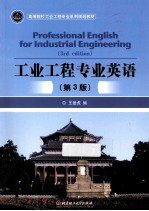图书介绍
工业工程专业英语 第3版pdf电子书版本下载

- 王爱虎编 著
- 出版社: 北京:北京理工大学出版社
- ISBN:9787564077099
- 出版时间:2013
- 标注页数:312页
- 文件大小:139MB
- 文件页数:328页
- 主题词:工业工程-英语-高等学校-教材
PDF下载
下载说明
工业工程专业英语 第3版PDF格式电子书版下载
下载的文件为RAR压缩包。需要使用解压软件进行解压得到PDF格式图书。建议使用BT下载工具Free Download Manager进行下载,简称FDM(免费,没有广告,支持多平台)。本站资源全部打包为BT种子。所以需要使用专业的BT下载软件进行下载。如 BitComet qBittorrent uTorrent等BT下载工具。迅雷目前由于本站不是热门资源。不推荐使用!后期资源热门了。安装了迅雷也可以迅雷进行下载!
(文件页数 要大于 标注页数,上中下等多册电子书除外)
注意:本站所有压缩包均有解压码: 点击下载压缩包解压工具
图书目录
第一篇 对工业工程的认识 3
CHAPTER 1 Industrial Engineering Education for the 21st Century 3
1.1 Introduction 3
1.2 Quality in IE education 4
1.3 Theory and practice 4
1.4 Curriculum integration 4
1.5 Role of the IE 5
1.6 Ethics in education 6
1.7 Curriculum assessment 7
1.8 Conclusions 7
CHAPTER 2 Real IE Value 9
2.1 Introduction 9
2.2 The name game 9
2.3 Curriculum 11
2.4 Other steps 12
2.5 Expectations 13
2.6 Future directions 14
2.7 More challenges 15
CHAPTER 3 Grand Challenges for Industrial Engineering in the 21st Century 19
3.1 Background and introduction 19
3.2 NAE grand challenges 20
3.3 IIE council of fellows role for industrial engineering 21
3.4 A research and contribution plan for industrial engineering 23
3.5 Futurizing the IE curriculum 25
3.6 Summary and conclusions 27
第二篇 基础工业工程 33
CHAPTER 4 Operations Research 33
4.1 Brief history 33
4.2 Some OR accomplishments 34
4.3 An outlook on a research agenda 36
CHAPTER 5 Work-Measured Labor Standards 42
5.1 Introduction 42
5.2 Developing standard times 43
5.3 Maintaining standard times 45
5.4 Summary 46
CHAPTER 6 Ergonomics 49
6.1 The origin of ergonomics 49
6.2 A system description of ergonomics 51
6.3 The goal of safety 54
6.4 The goal of productivity 55
6.5 The trade-off between productivity and safety 55
6.6 The goal of operator satisfaction 56
6.7 Conclusion 56
CHAPTER 7 Research Challenges and Recent Progress in Next Generation Factory Layouts 60
7.1 Introduction 60
7.2 Emerging trends in industry 62
7.3 Next generation factory layouts 65
7.4 Research challenges 67
CHAPTER 8 Operations Management 71
8.1 Celebration of history and accomplishments 71
8.2 The challenges of the 1970s and 1980s and the response 72
8.3 The department’s history and current editorial mission 75
8.4 The way forward 78
CHAPTER 9 The Role of IE in Engineering Economics 83
9.1 Introduction 83
9.2 Engineering economics 84
9.3 Steps in the evaluation process 86
9.4 Analytical problems encountered 87
9.5 Tools of engineering economy 88
9.6 The potential of IE for the firm 91
CHAPTER 10 Systems Engineering and Engineering Management 94
10.1 Nature of system development 94
10.2 Systems engineering and engineering management 96
10.3 Overlap, difference, and synergies 98
第三篇 现代工业工程 103
CHAPTER 11 Concurrent Engineering 103
11.1 Introduction 103
11.2 The training philosophy 103
CHAPTER 12 New Product Development 110
12.1 Introduction 110
12.2 What is the “Front End”? 111
12.3 A well-engineered front-end process 114
12.4 Balancing front-end explicitness and flexibility 115
12.5 Diagnosing front-end activities 115
12.6 Managing the transition 116
12.7 Conclusion 118
CHAPTER 13 Computer Integrated Manufacturing (CIM) 121
13.1 Computer-aided design 121
13.2 Computer-aided engineering 122
13.3 Computer-aided manufacturing 123
13.4 Networks 125
13.5 Other key elements of factory automation 126
CHAPTER 14 The Evolution of Simulation 134
14.1 Introduction 134
14.2 The early days 135
14.3 Technical factors in simulation development 136
14.4 Organizational factors 145
14.5 Concluding summary 147
第四篇 丰田制造模式 155
CHAPTER 15 Classification of JIT Techniques 155
15.1 JIT’s pure engineering elements 155
15.2 Worker’s operations/activities as JIT elements 156
15.3 Japanese management-related elements of JIT 156
15.4 Is the classification justifiable? 157
15.5 Significance of the classification 158
15.6 Lessons 158
15.7 Summary 161
CHAPTER 16 Industrial Engineering of the Toyota Production System 163
16.1 Introduction 163
16.2 Continuous material flow 164
16.3 Holistic view of TPS 166
16.4 Ancient rite of waste elimination 167
16.5 Three pathways 168
16.6 The Gilbreths’ “four step” approach 170
16.7 Origin of the MOI2 process chart 171
16.8 Contemporary dustrial engineering 172
16.9 Shigeo Shingo and the JMA 174
16.10 Discussion 175
16.11 Conclusions 176
CHAPTER 17 Toyota’s Practical Thinking Shared Among Its Employees 179
17.1 Introduction 179
17.2 Literature review 180
17.3 Research approach 187
17.4 Conclusions 187
第五篇 工业工程前沿 193
CHAPTER 18 Total Quality Management 193
18.1 Introduction 193
18.2 The research problem 195
18.3 The critical dimensions of TQS 195
18.4 Summary 201
CHAPTER 19 Agile Manufacturing 204
19.1 Introduction 204
19.2 Agile manufacturing—definitions 205
19.3 Agile manufacturing strategies and technologies 209
19.4 A framework for the development of agile manufacturing 209
19.5 Summary and conclusions 210
CHAPTER 20 Theory of Constraints 213
20.1 Introduction 213
20.2 Historical background and basic concepts of TOC 213
20.3 Issues and research opportunities 217
CHAPTER 21 Experimental Economics and Supply Chain Management 222
21.1 Introduction 222
21.2 Why do we need an experiment? 224
21.3 The beer distribution game 225
21.4 Behavioral causes of the bullwhip effect 227
21.5 Methods for reducing the bullwhip effect 228
21.6 Conclusions and lessons for managers 232
第六篇 工业工程展望 239
CHAPTER 22 The Evolution of Information Systems and Business Organization Structures 239
22.1 Introduction 239
22.2 Early developments 239
22.3 Computers in business 240
22.4 Growth of information systems and business organizations 241
22.5 Integrating computer architectures and organizational structures 244
22.6 The impact of computers on organizations 246
22.7 Phases of the computerization in organizations 247
22.8 Linkages between computers and organizational structures 248
22.9 Implications for emerging and future organizations 249
22.10 Internet, stand-alone computers and small businesses 250
CHAPTER 23 The New IE: Information Technology and Business Process Redesign 254
23.1 Introduction 254
23.2 IT in business process redesign 254
23.3 Redesigning business processes with IT:five steps 256
23.4 Defining process types 260
23.5 Management issues in IT-enabled redesign 262
23.6 Summary 265
CHAPTER 24 Post Industrial Engineering 268
24.1 Introduction 268
24.2 Methods 270
24.3 The history of work studies in IE 272
24.4 The changing nature of work 283
24.5 Bringing work back into IE 285
Summary of Professional Vocabularies and Expressions 291
Biblography 311